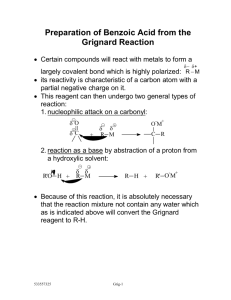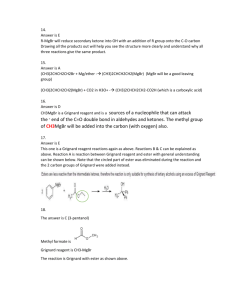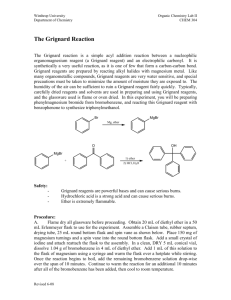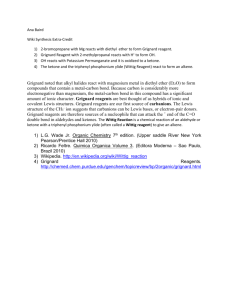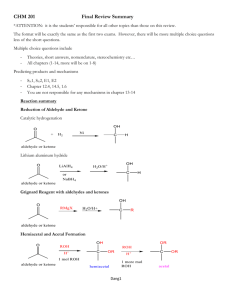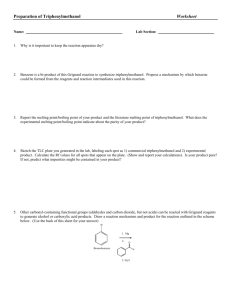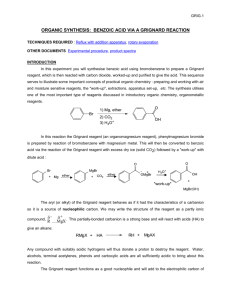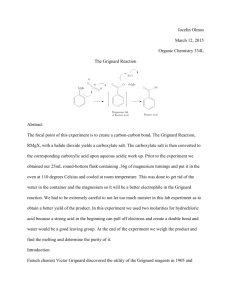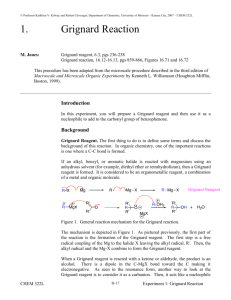handout grignard reaction
advertisement
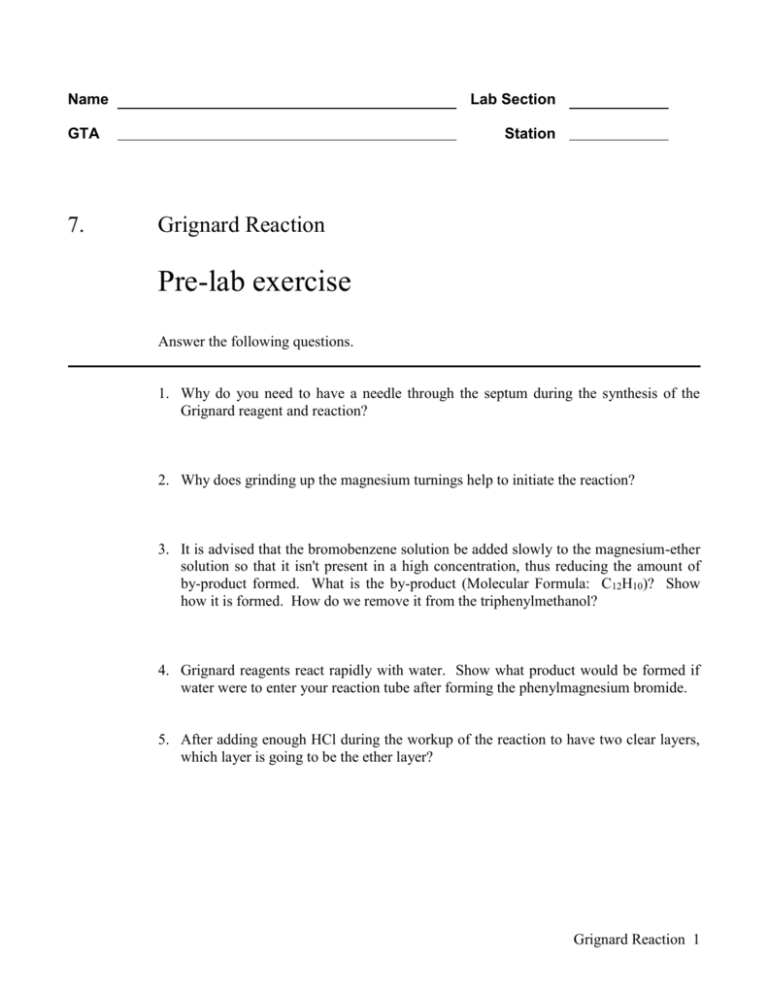
Name Lab Section GTA 7. Station Grignard Reaction Pre-lab exercise Answer the following questions. 1. Why do you need to have a needle through the septum during the synthesis of the Grignard reagent and reaction? 2. Why does grinding up the magnesium turnings help to initiate the reaction? 3. It is advised that the bromobenzene solution be added slowly to the magnesium-ether solution so that it isn't present in a high concentration, thus reducing the amount of by-product formed. What is the by-product (Molecular Formula: C12H10)? Show how it is formed. How do we remove it from the triphenylmethanol? 4. Grignard reagents react rapidly with water. Show what product would be formed if water were to enter your reaction tube after forming the phenylmagnesium bromide. 5. After adding enough HCl during the workup of the reaction to have two clear layers, which layer is going to be the ether layer? Grignard Reaction 1 7. Grignard reaction Jones: Grignard reagent, 15.10, pgs 734-735 Grignard reaction, 15.10, pgs 737-740, Figures 15.69, 15.70, 15.72, 15.73 McMurry: Grignard reagent, 7.3, pgs 215-217 Grignard reaction, 9.9, pgs 291-293 This procedure has been adapted from the microscale procedure described in the third edition of Macroscale and Microscale Organic Experiments by Kenneth L. Williamson (Houghton Mifflin, Boston, 1999). Background Grignard Reagent. In this experiment, you will first synthesize the Grignard reagent and then use it in a Grignard reaction. R MgX Mg R X H2O ether R H R MgX MgBr Br Mg D D2O ether R R O C O C 1) RMgX R 2) H 2O 1) RMgX H 2) H 2O OH R R R 1) addition 2) protonation yields a 3o alcohol OH H R R 1) addition 2) protonation yields a 2o alcohol Figure 1. Formation of Grignard reagents and their reactions with aldehydes and ketones Grignard Reaction 2 But first, let's define some terms and discuss the background of this reaction. In organic chemistry, one of the important reactions is one where a C-C bond is formed. If an alkyl, benzyl, or aromatic halide is reacted with magnesium using ether (diethyl ether or tetrahydrofuran for example) as the solvent, then a Grignard reagent is formed. It is considered to be an organometallic reagent, a combination of a metal and organic molecule. The general reaction for the formation of the Grignard reagent is depicted in Figure 1. When a Grignard reagent is reacted with a ketone or aldehyde, the product is an alcohol. There is a significant dipole in the C-MgX bond since C is more electronegative than Mg. As seen in the resonance form, another way to look at the Grignard reagent is to consider it as a carbanion. Thus, it acts like a nucleophile and adds to the carbonyl carbon. Mg R X R 'R R MgX O 'R R Mg X Mg X 'R R 'R H OH2 O MgX 'R R 'R Grignard Reagent OH + H 2O Figure 2. General reaction mechanism for the Grignard reaction. The mechanism is depicted in Figure 2. As pictured previously, the first part of the reaction is the formation of the Grignard reagent. The first step is a free radical coupling of the Mg to the halide X leaving the alkyl radical, R.. Then, the alkyl radical and the Mg-X combine to form the Grignard reagent. The Grignard reagent then adds to the carbonyl carbon of a ketone or aldehyde forming an alkoxide. In the workup of the reaction, an acid is added so that the alkoxide is protonated to form the alcohol product. In this experiment, you will be performing a Grignard reaction (see Figure 3). You will first synthesize the Grignard reagent starting from bromobenzene and magnesium using ether as the solvent. The reaction is moisture sensitive so you will be using anhydrous ether. In the second step, you will be adding your Grignard reagent to benzophenone to form triphenylmethanol. Grignard Reaction 3 Mg + Br Magnesium At.W. 24.31 anhydrous diethyl ether (ether) Phenylmagnesium bromide an intermediate but not isolated Bromobenzene bp 156 oC M.W. 157.02 density 1.491 g/mL O MgBr OH 1) ether 2) dilute HCl + Phenylmagnesium bromide MgBr Benzophenone mp 48-49 oC M.W. 182.22 Triphenylmethanol mp 160-163 oC M.W. 260.34 Figure 3. The overall reaction of this experiment. Experiment When performing the following experiment, note that you will be using three different kinds of ethers. It is important that you use the correct one at the correct time. Grignard Reagent Preparation Add 230 mg of magnesium turnings to a clean and dry large reaction tube (make sure your tube has no star cracks, if it does replace it with a new one). To the tube add 2 mL of ethyl ether and cap the tube tightly. Transfer 1.5 mL of bromobenzene from the reagent receptical to a small vial via syringe (make sure your syringe is clean and dry). Dilute the bromobenzene with 2 mL of ethyl ether. Remove 0.5 mL of the bromobenzene-ether solution with the syringe (cap the vial). Transfer this solution to the reaction tube. Place the reaction tube on your notebook and grind the magnesium with a large glass rod (if you grind too hard you will break out the bottom of the tube). Continue to grind until bubbling is observed and the solution turns cloudy. Cap the reaction tube with a rubber septum and insert a needle through the septum. Add 8 mL of ethyl ether to the reaction tube with a syringe. Wrap the upper portion of the tube with a wet paper towel and secure it with a rubber band. Continue to add the bromobenzene solution drop wise through the septum via syringe at a rate to continue a gentle reflux. The reaction is completed when either the magnesium is all consumed or refluxing has ceased. Grignard Reaction 4 Synthesis of Triphenylmethanol Weigh out 1.7 grams of benzophenone into a small vial. Add 4 mL of ethyl ether to this vial and cap it. Add the benzophenone solution drop wise to the Grignard reagent in the reaction tube via syringe through the septum. Refluxing should commence after 1 mL of the reagent is added. Continue to add the benzophenone at a rate to maintain a refluxing solution. Reaction Workup Remove the septum from the reaction tube. Add a small aliquot of the HCl solution to the tube. Use a glass rod to mix the solution. Continue to add small aliquots of HCl with mixing (if a lot of solid forms that makes mixing difficult add tert-butyl methyl ether or ethyl ether to help dissolve it). You are done when you have two clear layers and all the solids are dissolved. At this point cap the tube and shake. Let the contents settle; remove the aqueous layer. Wash the organic layer with 4 mL of a saturated NaCl solution and remove. Dry the organic solvent with calcium chloride. Remove the ethyl ether, filter it through a cotton plug, and place into a 50 mL Erlenmeyer flask. Wash the pellets with tert-butyl methyl ether or ethyl ether, filter and combine with the extract. Evaporate off the solvent in the hood. Solidify the remaining oil in ice. While in ice, wash the solid with 1 mL portions (~3 to 4 times) of petroleum ether until white crystalline solid remains. Remove each petroleum ether wash with a pipet fitted with a cotton plug. Recrystallize the remaining solid from ethanol. Grignard Reaction 5 Name Lab Section GTA 7. Station Grignard Reaction Post-lab report Fill out the appropriate sections below. Show all work. Initial weight of bromobenzene Initial weight of magnesium Initial weight of benzophenone Final amount of product Theoretical yield % yield melting point (°C) Calculations: Grignard Reaction 6 Complete the following questions and submit with your report. 1. Propose the starting materials needed to prepare the following compounds by the Grignard reaction. OH CH2 CH3 CH3 a) OH H CH3 b) OH c) H3CH 2C CH2 CH2CH3 CH3 O d) OH 2. Any unreacted magnesium was destroyed in the workup by HCl. Give a balanced equation for the reaction. Has the magnesium been oxidized or reduced? Grignard Reaction 7
